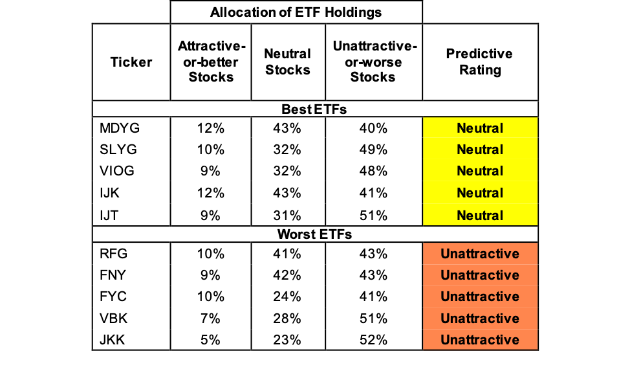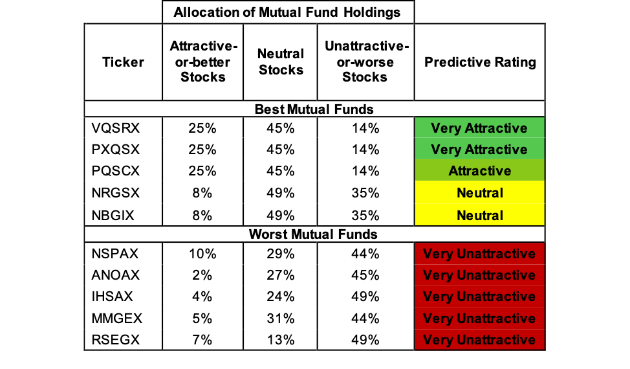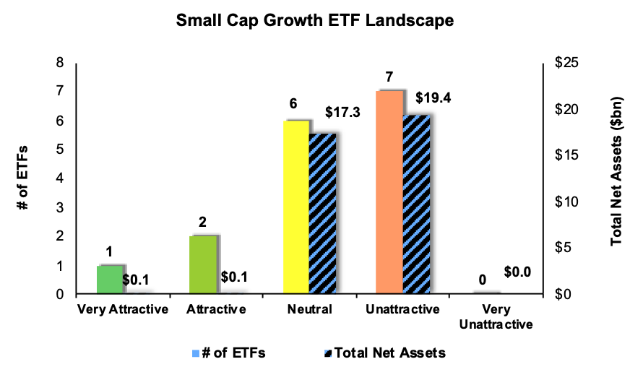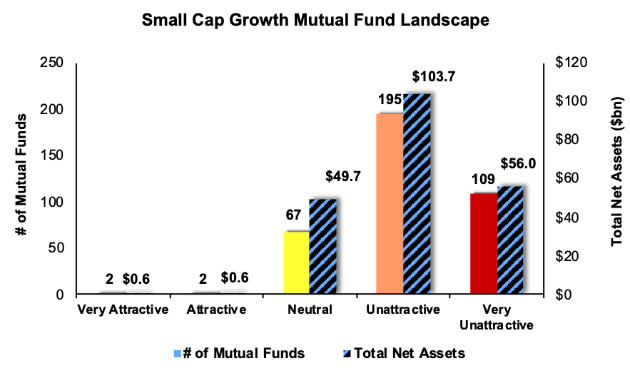The Small Cap Growth style ranks last out of the twelve fund styles as detailed in our 2Q19 Style Ratings for ETFs and Mutual Funds report. Last quarter, the Small Cap Growth style ranked last as well. It gets our Very Unattractive rating, which is based on an aggregation of ratings of 16 ETFs and 375 mutual funds in the Small Cap Growth style as of April 23, 2019. See a recap of our 1Q19 Style Ratings here.
Figures 1 and 2 show the five best and worst-rated ETFs and mutual funds in the style. Not all Small Cap Growth style ETFs and mutual funds are created the same. The number of holdings varies widely (from 27 to 2534). This variation creates drastically different investment implications and, therefore, ratings.
Investors seeking exposure to the Small Cap Growth style should buy one of the Attractive-or-better rated mutual funds from Figure 2.
Our Robo-Analyst technology[1] empowers our unique ETF and mutual fund rating methodology, which leverages our rigorous analysis of each fund’s holdings.[2] We think advisors and investors focused on prudent investment decisions should include analysis of fund holdings in their research process for ETFs and mutual funds.
Figure 1: ETFs with the Best And Worst Ratings – Top 5

* Best ETFs exclude ETFs with TNAs less than $100 million for inadequate liquidity.
Sources: New Constructs, LLC and company filings
VictoryShares U.S. Small Cap High Dividend Volatility Weighted Index ETF (NASDAQ:CSB), Janus Henderson Small/Mid Cap Growth Alpha ETF (NASDAQ:JSMD), and Janus Henderson Small Cap Growth Alpha ETF (NASDAQ:JSML) are excluded from Figure 1 because their total net assets (NYSE:TNA) are below $100 million and do not meet our liquidity minimums.
Figure 2: Mutual Funds with the Best & Worst Ratings – Top 5

* Best mutual funds exclude funds with TNAs less than $100 million for inadequate liquidity.
Sources: New Constructs, LLC and company filings
River Oak Discovery Fund (RIVSX) is excluded from Figure 2 because its total net assets (TNA) are below $100 million and do not meet our liquidity minimums.
State Street (NYSE:STT) SPDR S&P 400 Mid Cap Growth ETF (NYSE:MDYG) is the top-rated Small Cap Growth ETF and Virtus KAR Small Cap Value Fund (VQSRX) is the top-rated Small Cap Growth mutual fund. MDYG earns a Neutral rating and VQSRX earns a Very Attractive rating.
iShares Morningstar Small Cap Growth ETF (NYSE:JKK) is the worst rated Small Cap Growth ETF and Victory RS Small Cap Growth Fund (RSEGX) is the worst rated Small Cap Growth mutual fund. JKK earns an Unattractive rating and RSEGX earns a Very Unattractive rating.
The Danger Within
Buying a fund without analyzing its holdings is like buying a stock without analyzing its business and finances. Put another way, research on fund holdings is necessary due diligence because a fund’s performance is only as good as its holdings’ performance. Don’t just take our word for it, see what Barron’s says on this matter.
PERFORMANCE OF HOLDINGs = PERFORMANCE OF FUND
Analyzing each holding within funds is no small task. Our Robo-Analyst technology enables us to perform this diligence with scale and provide the research needed to fulfill the fiduciary duty of care. More of the biggest names in the financial industry (see At BlackRock (NYSE:BLK), Machines Are Rising Over Managers to Pick Stocks) are now embracing technology to leverage machines in the investment research process. Technology may be the only solution to the dual mandate for research: cut costs and fulfill the fiduciary duty of care. Investors, clients, advisors and analysts deserve the latest in technology to get the diligence required to make prudent investment decisions.
Figures 3 and 4 show the rating landscape of all Small Cap Growth ETFs and mutual funds.
Figure 3: Separating the Best ETFs from the Worst Funds

Sources: New Constructs, LLC and company filings
Figure 4: Separating the Best Mutual Funds from the Worst Funds

Sources: New Constructs, LLC and company filings
